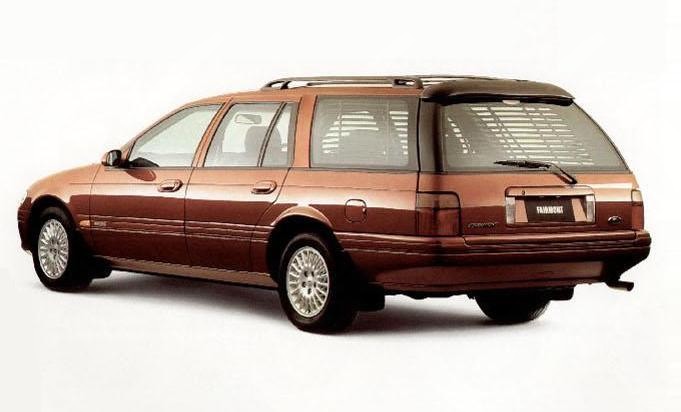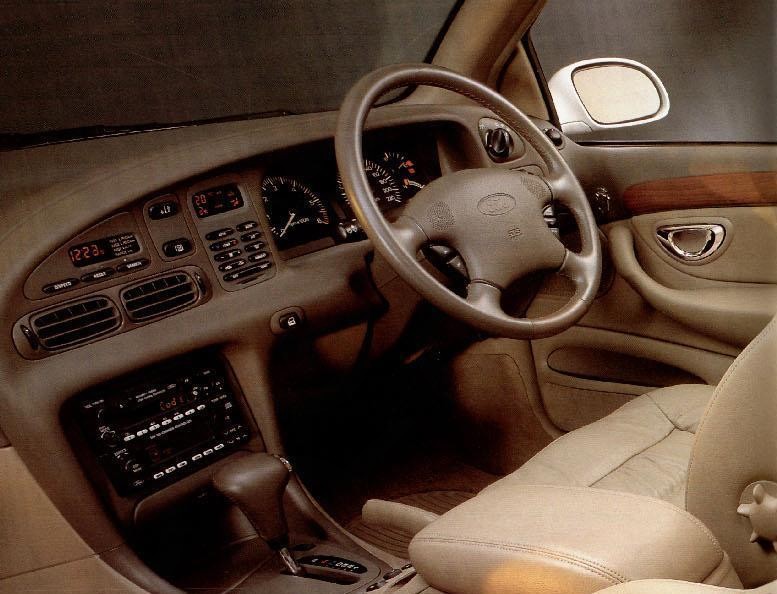
- Responsive engines
- Spacious interior
- Folding rear seats add to cargo capacity
- Good visibility
- Comfortable ride…
- … but suspension design can cause roll-oversteer
- Vague steering
- Poor standard of fit and finish
- Inadequate air conditioning system
- Basic live rear axle suspension
Review: Ford EF.I Fairmont (1994-95)
Overview
Released in August 1994, the Ford EF Series I (EF.I) Fairmont was available as a sedan or wagon, while the Fairmont Ghia was solely as available as the former. Manufactured in Campbellfield, Victoria, the rear-wheel drive Fairmont was available with either a 4.0-litre inline six-cylinder petrol engine or a 4.9-litre V8 petrol engine. A four-speed automatic transmission was fitted as standard across the range.
Engines
Of the engines,
- the 4.0-litre inline six cylinder engine had a casst iron block, an alloy cylinder head, a single overhead camshaft (SOHC, two valves per cylinder and a compression ratio of 9.3:1. For the EF Falcon, this engine had was fitted with upgraded internal components, a dual intake system and a new EEC-V engine management system; and,
- the 4.9-litre pushrod V8 engine had a cast iron block and cylinder head, two valves per cylinder and a compression ratio of 9.0:1.
Dimensions and suspension
The EF Fairmont sedan was 4906 mm long, 1861 mm wide, 1453 mm tall and had a 2791 mm long wheelbase. The wagon models, however, were 136 mm longer (at 5042 mm), 5 mm narrower (1856 mm), 76 mm taller (1529 mm) and had 132 mm longer wheelbases (2923 mm). Furthermore, the EF Fairmont had Short Long Arm (SLA) front suspension and sedans had a live rear axle with four trailing arms and Watts linkages; wagons, however, had a live rear axle with leaf springs.
EF Changes
Compared to its ED predecessor, the EF Fairmont could be identified by its more rounded body panels and elongated headlights. Inside, cup holders were fitted as standard and there was a new floor-mounted hand brake. The EF Falcon was also fitted with new a crankshaft and hydraulic engine mounts for greater refinement.
| Body | Engine | Trans. | Peak power | Peak torque | |
|---|---|---|---|---|---|
| Fairmont | Sedan, Wagon |
4.0-litre petrol I6 | 4sp auto | 157 kW at 4900 rpm | 357 Nm at 3000 rpm |
| 4.9-litre petrol V8 | 4sp auto | 165 kW at 4750 rpm | 388 Nm at 300 rpm | ||
| Fairmont Ghia | Sedan | 4.0-litre petrol I6 | 4sp auto | 157 kW at 4900 rpm | 357 Nm at 3000 rpm |
| 4.9-litre petrol V8 | 4sp auto | 165 kW at 4750 rpm | 388 Nm at 300 rpm |
Safety equipment
Standard safety equipment for the EF Fairmont included a driver’s airbag and ABS. Beyond this, the Fairmont Ghia was further equipped with a front passenger airbag.
Features
Standard features for the EF Fairmont included 15-inch alloy wheels, an eight speaker sound system (six speakers for wagons), climate control air conditioning, velour seats, cruise control, 60/40 split and folding rear seats, remote central locking, power windows and mirrors, a rake and reach adjustable steering wheel, height adjustable driver’s seat, trip computer and immobiliser; wagon models were also fitted with roof racks.
The Fairmont Ghia was further equipped with a nine speaker, 250 watt sound system sound system with Digital Signal Processing and a six-stack boot-mounted CD player, velour seat facings with leather bolsters and a leather-wrapped steering wheel.
Review: Ford EF.II Fairmont (1995-96)
Overview
Released in October 1995, the EF Series II (EF.II) Fairmont introduced a revised range as the Fairmont Ghia was fitted with a more powerful six cylinder engine, lowered suspension, limited slip rear differential, uprated front springs and additional chrome highlights. Furthermore, the front suspension of the Fairmont and Fairmont Ghia was modified for more stable cornering by raising the position of the front ball joint, reducing toe-in, fitting a thicker anti-roll bar and firmer lower wishbone bushes.
Visually, the EF.II Fairmont and Fairmont Ghia could be identified by their convex passenger-side door mirror. Inside, there was reduced front seat padding for a lower driving position and reduced cabin noise due to the introduction of neoprene rubber insulation.
| Body | Engine | Trans. | Peak power | Peak torque | |
|---|---|---|---|---|---|
| Fairmont | Sedan, Wagon |
4.0-litre petrol I6 | 4sp auto | 157 kW at 4900 rpm | 357 Nm at 3000 rpm |
| 4.9-litre petrol V8 | 4sp auto | 165 kW at 4750 rpm | 388 Nm at 300 rpm | ||
| Fairmont Ghia | Sedan | 4.0-litre petrol I6 | 4sp auto | 162 kW at 4900 rpm | 361 Nm at 3000 rpm |
| 4.9-litre petrol V8 | 4sp auto | 165 kW at 4750 rpm | 388 Nm at 300 rpm |
Safety equipment
Compared to their EF.I predecessors, standard safety equipment for the EF.II was largely unchanged. For models with front bench seats, however, the Fairmont Ghia was fitted with a front passenger airbag which provided protection for the front, middle passenger.
Features
Standard features for the EF.II Fairmont was largely unchanged, though the Fairmont Ghia was fitted with leather upholstery as standard.
Related links




